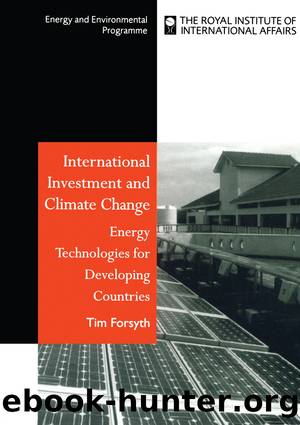International Investment and Climate Change: Energy Technologies for Developing Countries by Tim Forsyth

Author:Tim Forsyth [Forsyth, Tim]
Language: eng
Format: epub
Tags: Public Policy, Environmental Policy, Political Science
ISBN: 9781134192106
Google: Q8ZQAwAAQBAJ
Goodreads: 21924586
Publisher: Routledge
Published: 1999-03-01T00:00:00+00:00
Source: World Bank et al (1996:37)
Some of these projects have created opportunities for foreign investors. The Thac Mo 150 MW project has been implemented with Ukrainian assistance and equipment, reflecting Vietnamâs old trading links with the former Soviet Union. The Vinh Soc 66 MW project was the first major project with Western involvement, with assistance from Electricité de France in 1990. A French consortium led by Cegelec also supplied equipment. Japanese consultants have assisted with the Ham Thuan 300 MW project (Head, 1994).
However, there has also been recent interest in building smaller renewable energy applications. One project co-organized by the Vietnamese Womenâs Union (VWU) and the Solar Electric Light Fund (SELF) has sought to introduce US-manufactured PV and battery technology into rural villages, but in conjunction with local organizations. The project also aims to recover investorsâ costs by seeking payment from end users (see Box 7.1).
Box 7.1: The SELF â Vietnamese Womenâs Union Solar Energy Project
The project is entitled, âSolar Project in Support of Rural Women and Childrenâ, and began in December 1994 in the three provinces of Tra Vinh and Tien Gang in the south, and Hoa Binh in the north. The project provided PV technology to five communes, in the first stage a total of 130 Solar Home Systems (SHS) were installed, including two street lighting systems.
The SHS were manufactured by United Solar Systems Corporation of the United States. The project provided training to ten technicians and also involved monitoring the success of the equipment and the availability of maintenance facilities if necessary. The capacity of the SHS were 22.5 Wp each.
Households paying for the SHS make an initial down-payment of 20 per cent, and then pay monthly contributions for four years. The second phase of the project is to increase the module size to 35 Wp.
The long-term aim of the project is to provide SHS to 1 million households before 2010. SELF is also collaborating with the World Bank to assess ways to integrate PV electricity into grid systems.
Source: Solar Electric Company, Washington, DC
Download
This site does not store any files on its server. We only index and link to content provided by other sites. Please contact the content providers to delete copyright contents if any and email us, we'll remove relevant links or contents immediately.
| Anthropology | Archaeology |
| Philosophy | Politics & Government |
| Social Sciences | Sociology |
| Women's Studies |
The Secret History by Donna Tartt(18211)
The Social Justice Warrior Handbook by Lisa De Pasquale(11957)
Thirteen Reasons Why by Jay Asher(8466)
This Is How You Lose Her by Junot Diaz(6457)
Weapons of Math Destruction by Cathy O'Neil(5844)
Zero to One by Peter Thiel(5503)
Beartown by Fredrik Backman(5369)
The Myth of the Strong Leader by Archie Brown(5244)
The Fire Next Time by James Baldwin(5025)
How Democracies Die by Steven Levitsky & Daniel Ziblatt(4967)
Promise Me, Dad by Joe Biden(4912)
Stone's Rules by Roger Stone(4867)
100 Deadly Skills by Clint Emerson(4697)
A Higher Loyalty: Truth, Lies, and Leadership by James Comey(4559)
Rise and Kill First by Ronen Bergman(4549)
Secrecy World by Jake Bernstein(4402)
The David Icke Guide to the Global Conspiracy (and how to end it) by David Icke(4387)
The Farm by Tom Rob Smith(4329)
The Doomsday Machine by Daniel Ellsberg(4250)
